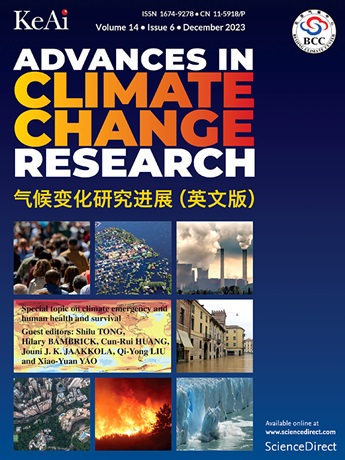CMIP6模式对青藏高原南坡夏季降水趋势模拟的亚选择校正
IF 5.2
1区 地球科学
Q1 ENVIRONMENTAL SCIENCES
引用次数: 0
摘要
青藏高原降水对亚洲水平衡和全球气候格局至关重要。青藏高原南坡是夏季降水中心,近几十年来经历了长期的干旱趋势。SSTP夏季降水变化的准确模拟和预估对未来的可持续发展至关重要。然而,来自当前最先进的耦合模式比对项目第6阶段的多模式集合(MME)表明,在1965-2014年期间,SSTP的湿润趋势(每十年每月~ 2.58 mm)与观测值(每十年每月~ - 2.95 mm)相矛盾。这种差异可归因于CMIP6模式对温室气体(GHG)对降水趋势的刺激作用的高估。传统的MME在捕捉大气垂直运动和水汽对SSTP上温室气体强迫的响应方面能力有限,导致垂直水汽平流和热力控制的水平水汽平流对湿化产生偏湿。采用子选择方法对各栅格点的历史模拟湿润趋势进行校正,所选的MME (SMME)更合理地表征了降水对温室气体强迫的响应,并再现了观测到的干燥趋势,其值约为- 1.95 mm /月/ 10年。由于预计温室气体将是未来的主要外部强迫,因此将这种方法推广到未来的预估中。在中等排放和高排放情景下,SMME的预测结果在2050-2099年期间分别为61.8%和76.4%。本文章由计算机程序翻译,如有差异,请以英文原文为准。
Calibrating the simulated summer precipitation trend over the southern slope of the Tibetan Plateau in CMIP6 models using a sub-selection method
Precipitation on the Tibetan Plateau (TP) is crucial for Asian water balance and global climate patterns. The southern slope of the TP (SSTP), a precipitation center in summer, has experienced a long-term drying trend in recent decades. Accurate simulations and projections of the change in summer precipitation over the SSTP are critical for future sustainable development. However, the multi-model ensemble (MME) from the current state-of-art Coupled Model Intercomparison Project Phase 6 indicates a wetting trend (∼2.58 mm per month per decade) over the SSTP during the period 1965–2014, contradicting the observations (∼−2.95 mm per month per decade). This discrepancy can be attributed to an overestimation of the stimulating impact of greenhouse gas (GHG) on precipitation trend in CMIP6 models. The traditional MME shows limited capability in capturing the response of atmospheric vertical motions and water vapor to the GHG forcing across the SSTP, resulting in wetting biases by the vertical moisture advection and thermodynamically controlled horizontal moisture advection. A sub-selection method is introduced to calibrate the historical simulated wetting trend at each grid point, through which the selected MME (SMME) more reasonably characterizes the precipitation response to GHG forcing and reproduces the observed drying trend, showing a value about −1.95 mm per month per decade. As GHGs are expected to be the major external forcing in the future, this method is extended to future projections. For the anticipated future wetting trend over the SSTP, the SMME results are constrained to 61.8% and 76.4% in the moderate- and high-emission scenarios, respectively, for the period 2050–2099.
求助全文
通过发布文献求助,成功后即可免费获取论文全文。
去求助
来源期刊

Advances in Climate Change Research
Earth and Planetary Sciences-Atmospheric Science
CiteScore
9.80
自引率
4.10%
发文量
424
审稿时长
107 days
期刊介绍:
Advances in Climate Change Research publishes scientific research and analyses on climate change and the interactions of climate change with society. This journal encompasses basic science and economic, social, and policy research, including studies on mitigation and adaptation to climate change.
Advances in Climate Change Research attempts to promote research in climate change and provide an impetus for the application of research achievements in numerous aspects, such as socioeconomic sustainable development, responses to the adaptation and mitigation of climate change, diplomatic negotiations of climate and environment policies, and the protection and exploitation of natural resources.
 求助内容:
求助内容: 应助结果提醒方式:
应助结果提醒方式:


